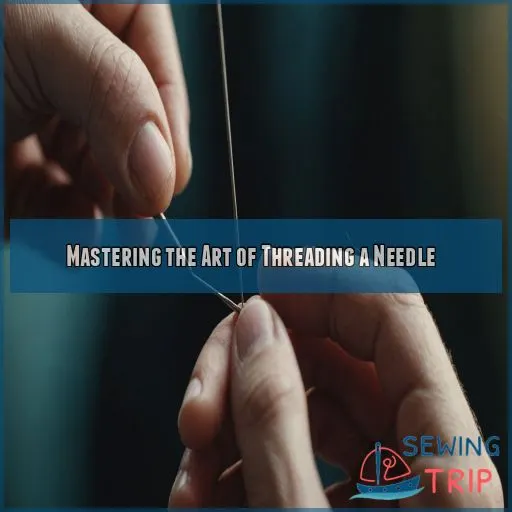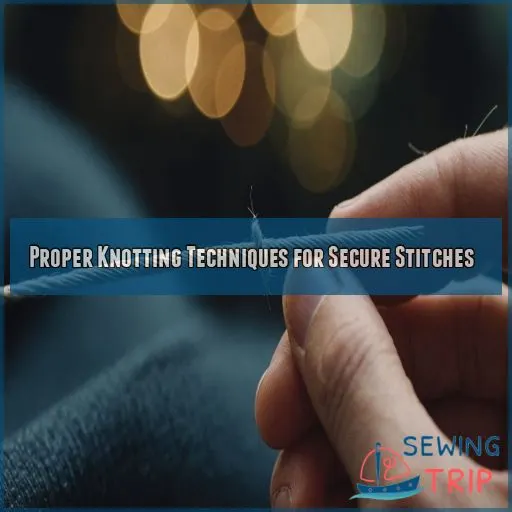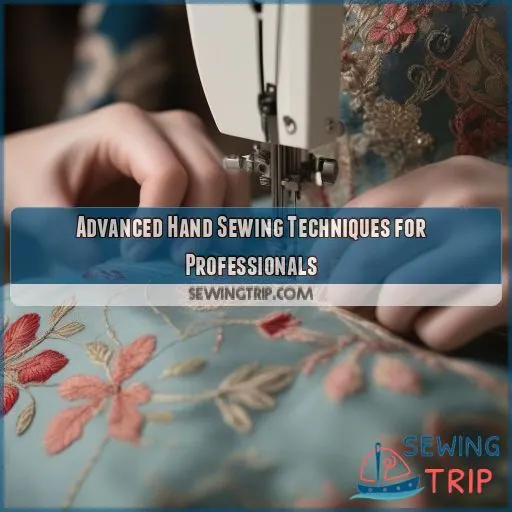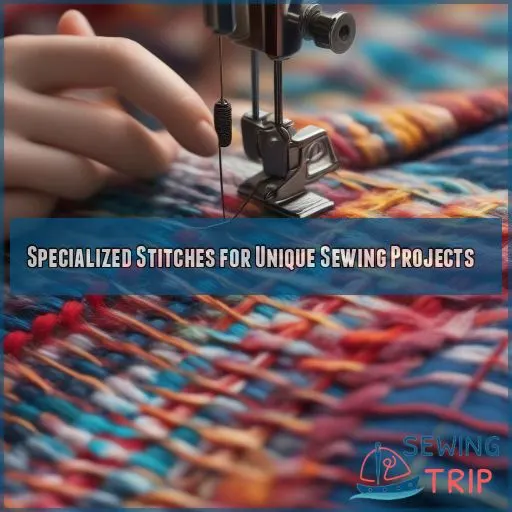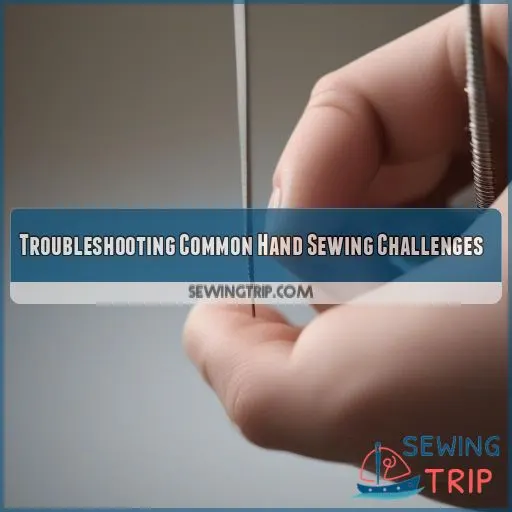This site is supported by our readers. We may earn a commission, at no cost to you, if you purchase through links.
 Want to sew like a pro? Master the top hand sewing techniques that can turn your projects from drab to fab!
Want to sew like a pro? Master the top hand sewing techniques that can turn your projects from drab to fab!
The backstitch is a great place to start, as it’s perfect for creating strong seams. The slip stitch is another essential technique, ideal for creating invisible hems like those you might find in a garment’s hemline.
If you’re basting or gathering, the running stitch is your go-to friend. It’s a simple yet effective stitch that can be used in a variety of situations.
The blanket stitch is a decorative stitch that adds flair to any edge. It’s a great way to add a professional finish to your projects.
Practice makes perfect, so keep at it until you’re stitching like a seasoned tailor. Before you know it, you’ll be sewing like it’s second nature.
Table Of Contents
- Key Takeaways
- Essential Hand Sewing Supplies for Beginners
- Mastering the Art of Threading a Needle
- Proper Knotting Techniques for Secure Stitches
- Fundamental Hand Stitches Every Sewer Should Know
- Advanced Hand Sewing Techniques for Professionals
- Specialized Stitches for Unique Sewing Projects
- Troubleshooting Common Hand Sewing Challenges
- Enhancing Hand Sewing Efficiency and Comfort
- Frequently Asked Questions (FAQs)
- Conclusion
Key Takeaways
- Don’t underestimate the power of the right stitch. Mastering techniques like the backstitch, slip stitch, and running stitch will turn your projects from bland to grand. Think of them like the secret sauce in your sewing recipe.
- Arm yourself with the tools of the trade. A solid set of needles, sharp scissors, and trusty thimbles are like having a sewing superhero cape – protective and nicely equipped to tackle any sewing challenge.
- Threading a needle doesn’t have to feel like solving a cosmic puzzle. Choose needles with larger eyes, snip your thread at a 45-degree angle, and keep a needle threader handy. These little tricks are your secret weapons.
- Don’t let tangled threads and puckering fabric get you down. Keep your stitches even, your fabric aligned, and your workspace tidy – think of it as decluttering your sewing zen zone. Relax, breathe, and remember: even the best tailors started with a knotted mess.
Essential Hand Sewing Supplies for Beginners
You’re about to start your hand sewing journey, but first, let’s make sure you’ve got all the right tools in your arsenal.
From needles and thread to scissors and thimbles, we’ll cover the must-have supplies that’ll set you up for stitching success.
Needles and Thread Selection
Needles and thread are your sewing sidekicks. You’ll want a variety of each to tackle any project that comes your way. Let’s get started!
Scissors and Cutting Tools
Your trusty scissors are your best fabric-slicing sidekicks. Sharp blades make clean cuts, ensuring your hand-sewn projects look polished from the get-go.
Thimbles and Finger Protection
Sharp scissors are great, but let’s protect those digits! Thimbles aren’t just for grandma – they’re your fingers’ best friends during intense stitching sessions.
Measuring and Marking Tools
While protecting your digits is key, let’s size things up! Accurate measurements and clear markings are the secret sauce for pro-level hand sewing projects.
Fabric Preparation Essentials
Now that you’ve got your measuring tools sorted, let’s prep your fabric. It’s like setting the stage for a sewing masterpiece!
Mastering the Art of Threading a Needle
You’ve got your supplies ready, so let’s tackle the next hurdle: threading that pesky needle. It’s like trying to thread a camel through the eye of a needle, right? But fear not, with these pro tips, you’ll be a threading wizard in no time.
Here are some tips to help you master the art of threading a needle:
- Choose the right needle: Larger eyes are easier to thread
- Cut your thread at a 45-degree angle for a cleaner point
- Moisten the thread end slightly to stiffen it
- Use a needle threader for stubborn eyes
Proper Knotting Techniques for Secure Stitches
When you’re hand sewing, tying secure knots is essential.
Tying secure knots is like trying to find the TV remote – it’s essential and sometimes tricky.
Get ready to learn knot-tying magic that keeps your stitches from unraveling faster than a cat chasing a laser pointer.
Single and Double Knot Methods
Threading success leads us to knotting know-how. Single knots keep it small, double knots double your security.
Here’s a quick comparison of the two types of knots:
| Knot Type | Security Level | Size | Placement Precision | Alternatives |
|---|---|---|---|---|
| Single Knot | Moderate | Small | High | Tying two stitches |
| Double Knot | High | Medium | Moderate | French knotting |
Keep your needle, secure your peace of mind!
Anchoring Stitches for Strength
Anchoring stitches is all about stitch security. This is crucial for creating strong and durable seams.
Make sure thread tension is just right for optimal seam strength and unbeatable durability. This will help eliminate any weak points in your stitches.
Knot Placement and Concealment
Place knots where they won’t show, and keep them small yet sturdy. Tuck thread ends under fabric to hide them – no bulky bumps here!
Alternatives to Traditional Knots
Get creative with hidden knots! Instead of knots, try tiny backstitches or long stitches for a knotless start. Maintain thread tension with invisible knots for a polished finish.
Fundamental Hand Stitches Every Sewer Should Know
You’re about to enter the world of hand stitching, where mastering a few key stitches can turn you into a sewing superhero overnight.
From the versatile running stitch to the hidden magic of the slip stitch, these techniques will have you stitching with both precision and flair.
Impressing even your pickiest critics (like those finicky fabric goblins that hide your thimbles).
Running Stitch for Basting and Gathering
Let’s talk about the running stitch for basting and gathering! Remember these tips: 1. Vary stitch length, 2. Adjust tension, 3. Experiment with fabrics.
Backstitch for Strength and Durability
The backstitch is a versatile workhorse – it mimics machine stitching and provides unparalleled strength for mending, seams, and projects requiring durability.
Whipstitch for Edges and Seams
Backstitch mastered? You’re on a roll! Whipstitch’s up next—perfect for neat edges and seams. Vary it by fabric types, tools handy.
Blanket Stitch for Decorative Finishes
Stacks of fabric await your blanket stitch magic. Try these tips:
- Vary stitch length
- Use on felt
- Decorate edges
- Experiment with threads
Slip Stitch for Invisible Hems
You’ll love the slip stitch for invisible hems. This technique dances effortlessly around curves, keeping knit fabrics tidy and polished. Choose matching thread!
Advanced Hand Sewing Techniques for Professionals
Mastering advanced hand sewing techniques can elevate your sewing projects to a professional level.
French seams, ladder stitches, and catch stitches are expert-level skills that can help you tackle delicate fabrics and create invisible closures.
These skills can also help you achieve refined perfection in your sewing projects.
French Seams for Delicate Fabrics
When mastering stitches, consider French seams for delicate fabrics like silk and linen. They’re tidy, strong, and worth the practice.
- Fabric Choice: Silk and linen benefit greatly from french seams. These fabrics can be prone to fraying, but French seams help to enclose the raw edges and prevent this from happening.
- Seam Pressing: Iron carefully to keep seams flat. This is especially important when working with delicate fabrics, as it helps to prevent wrinkles and creases.
- Sewing Tips: Use patience; precision is key. French seams require a bit more time and effort to complete, but the end result is well worth it.
Ladder Stitch for Invisible Closures
Moving on from French seams, it’s time to master the Ladder Stitch for invisible closures. It’s like secret magic holding your projects together flawlessly.
| Stitch Type | Fabric Choices | Applications |
|---|---|---|
| Ladder Stitch | Cotton, Linen | Hidden closures, Seam finishing |
| French Seams | Silk, Satin | Delicate fabrics |
| Slip Stitch | Wool, Denim | Hems, Simple repairs |
Catch Stitch for Tailoring Applications
Mastered the elusive ladder stitch? Let’s catch the catch stitch craze for tailoring! Its variations work wonders on visible seams and holding firm.
Buttonhole Stitch for Custom Details
Elevate your projects with the versatile buttonhole stitch! Customize collars, cuffs, and more for a professional touch. Experiment with different variations to find your signature style.
Darning Techniques for Fabric Repair
Darning’s an art with darning needles. Match hole shapes, fabric types, and yarn thickness. Practical mending tips help your beloved clothes last!
Specialized Stitches for Unique Sewing Projects
Boost your creativity with specialized stitches to transform ordinary garments into one-of-a-kind masterpieces.
Whether you’re adding a charming detail or creating intricate designs, these techniques will make your sewing projects stand out in a crowd.
Embroidery Stitches for Embellishment
For a touch of whimsy, embroidery stitches add flair. Try French knots for texture or feather stitches for elegance. Experiment with floss types and free embroidery designs.
Quilting Stitches for Layered Fabrics
Quilting stitches add flair to layered fabrics.
Try decorative patterns like the feather stitch or grid-like crosshatch for a professional, heirloom-quality finish.
Experiment with stitch density and tension for best results.
Appliqué Techniques for Fabric Application
You’ve mastered quilting stitches; now it’s appliqué time! Choose vibrant appliqué materials, and select stunning designs. Carefully place and finish appliqués using the right tools for eye-catching flair!
Smocking Stitches for Texture and Gathering
Imagine fabric transforming into art! Smocking patterns create delightful textures. Choose lightweight fabric, try pleating variations, and explore stitch variations. Gathering techniques add that irresistible charm. Master smocking with flair!
Troubleshooting Common Hand Sewing Challenges
When your thread has a life of its own or your fabric puckers up like it’s cold, hand sewing can test your patience.
But don’t worry, taming those unruly threads and stubborn fabrics is just a few troubleshooting tips away.
Dealing With Tangled Thread
Tangled thread? No need to fret! Adjust your tension, try a smaller needle, and store spools properly. Knotting tricks can also help keep things tidy and smooth.
Preventing Fabric Puckering
Fabric puckering’s a real sewing bugbear, but don’t fret. Keep it at bay by following these tips:
- Maintain fabric tension.
- Watch stitch length.
- Press seams regularly.
- Align your fabric grain.
Correcting Uneven Stitches
Struggling with uneven stitches? First, check your stitch tension and hand position. Adjusting needle size based on fabric type often helps when you refer to a needle size comparison chart. Practice tips: slow down, breathe, and relax.
Managing Difficult Fabrics
When that pesky fabric’s acting up, treat it like a grumpy cat. Use sharp needles for thick fabrics, support stretch fabrics, and avoid frayed edges with ease!
Enhancing Hand Sewing Efficiency and Comfort
Enhance your hand sewing experience by adopting proper posture and ergonomics. Organize your sewing workspace, leverage time-saving tricks, and maintain your tools for a seamless and comfortable sewing session.
Proper Posture and Ergonomics
To prevent back pain while sewing, sit comfortably. A supportive chair’s key, plus ergonomic tools can reduce hand fatigue. Think of a relaxed body as your best tool!
Organizing Your Sewing Workspace
Feeling cramped? Get your sewing workspace neat as a pin! Efficient storage solutions, good lighting, and organized tools maximize comfort. Add sewing machine integration for seamless stitching adventures!
Time-Saving Hand Sewing Tricks
Efficient thread management is important! Cut thread no longer than your forearm to avoid tangles. Needle threading hacks include using beeswax for smoother stitching. These sewing shortcuts boost productivity!
Maintaining Hand Sewing Tools
Keep your tools in tip-top shape – sharpen scissors, clean needles, and store everything neatly. A well-maintained sewing kit means smooth sailing for your hand-sewn projects!
- Sharpen Scissors Regularly
- Clean Needles After Use
- Organize Tools in Storage
- Repair Damaged Equipment
Frequently Asked Questions (FAQs)
What fabrics are best for hand sewing projects?
This old saying still holds true today, especially when it comes to hand sewing.
For hand sewing, natural fabrics are your best friends. They include cotton, linen, and wool.
These fabrics are easy to work with and create a polished, long-lasting result.
How does fabric type affect stitch choice?
Choosing the right stitches for your fabric is crucial.
Heavyweight fabrics like denim have a distinct personality that requires sturdy stitches. In this case, backstitches are the perfect choice as they provide the necessary strength and durability.
On the other hand, delicate fabrics like silk demand a more gentle approach. For these fabrics, slip stitches are ideal as they are soft and won’t damage the material.
When working with stretchy fabrics like knit, it’s essential to choose stitches that can accommodate their elasticity. Zigzag stitches are perfect for this type of fabric as they allow for flexibility and movement, keeping everything smooth and unruffled.
Can hand sewing replace machine sewing entirely?
Around 50% of sewing enthusiasts still rely on hand sewing for creative freedom and control.
You’ll find it can’t fully replace machines for speed and precision but offers unmatched versatility, like painting instead of snapping a photo.
What tools enhance hand sewing precision?
Boost your hand sewing precision with a few essential tools.
A sharp needle, quality thread, and good lighting are the foundation of precise hand sewing.
Add a few more tools to your kit for extra protection and convenience. A thimble will protect your fingers from the needle, while a seam ripper will help you make quick fixes.
To guide your stitches like a sewing pro, use tailor’s chalk to mark your fabric and ensure accurate stitching.
How do I maintain even stitch tension?
To maintain even stitch tension, keep your thread taut but not too tight.
Gently guide the fabric as you sew, avoiding tugging or pulling.
Relax your grip and let the needle glide smoothly through the layers.
Conclusion
If you think hand sewing is old-fashioned or intimidating, think again. With these top hand sewing techniques, you’ll transform your skills from amateur to artisan in no time.
Embracing the challenge of hand sewing can be quite rewarding. Sewing can be quite therapeutic, allowing you to express your creativity while crafting beautiful stitches.
To master hand sewing, remember that practice makes perfect, like when you learn how to sew silk fabric by hand. With patience, even the most complex stitches will become second nature.


